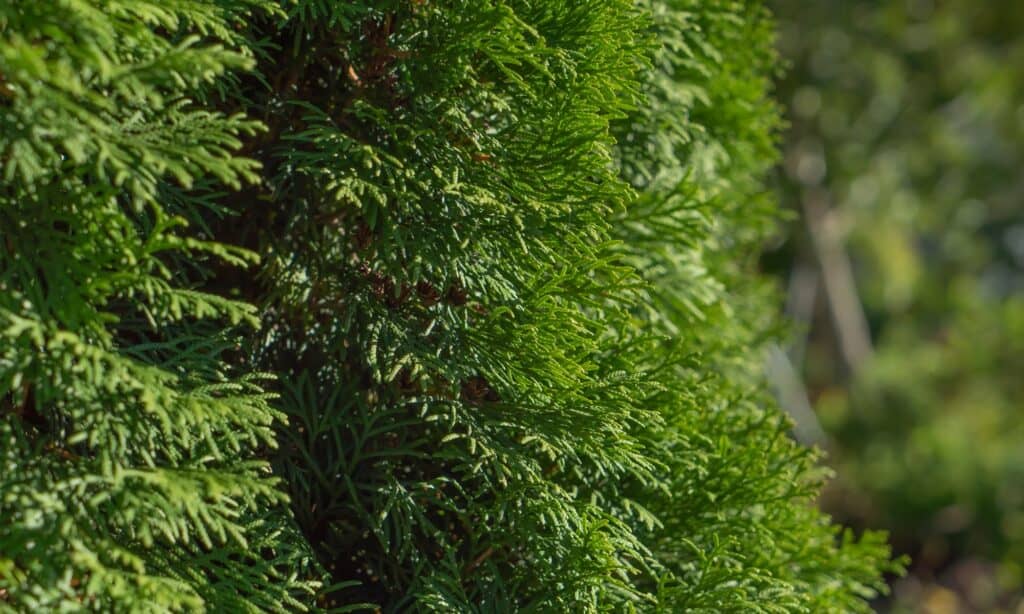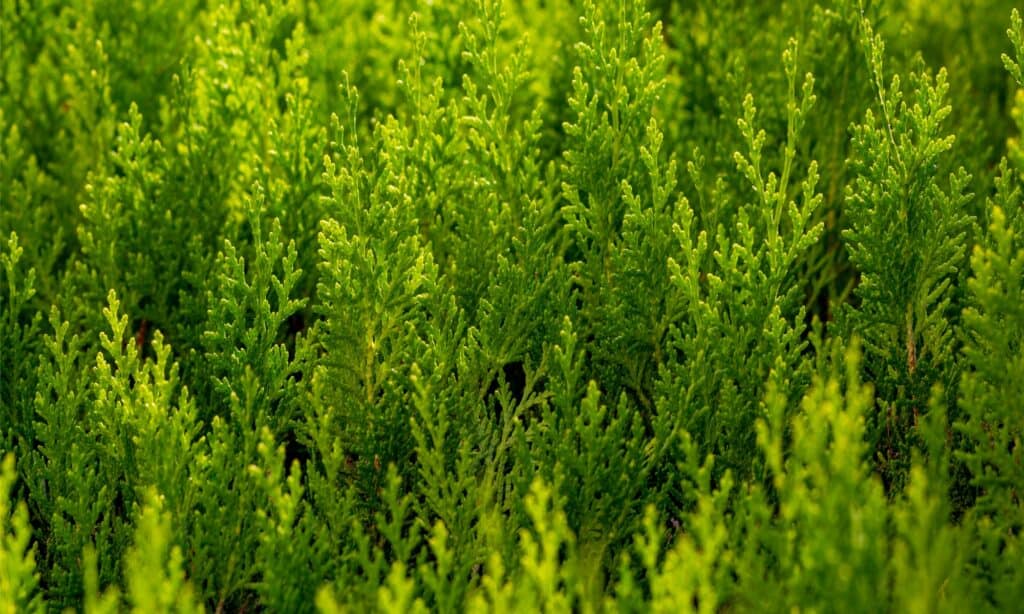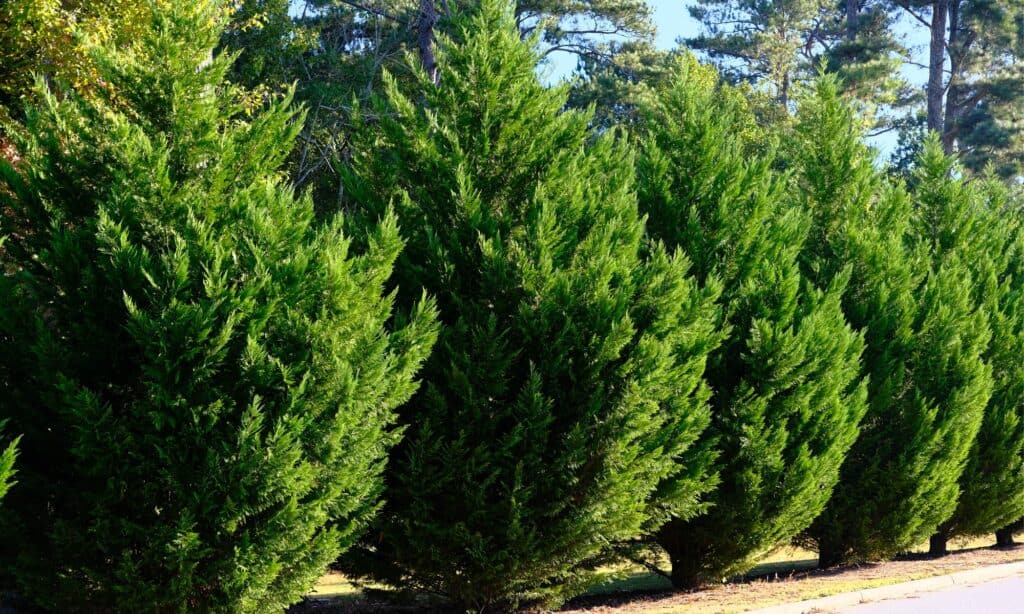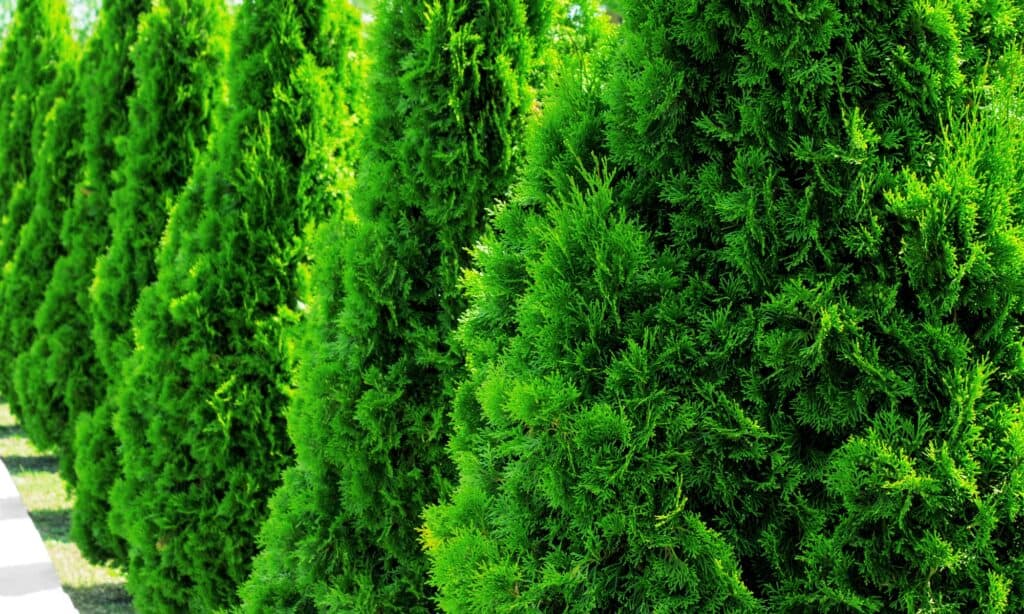When it comes to comparing two potentially useful landscaping trees, what are all of the differences between the Green Giant Arborvitae vs Leyland cypress? These two tree varieties are extremely similar in their appearances and uses, but what might the differences be between them so that you can determine which one works best in your own backyard?
In this article, we will compare and contrast the Green Giant Arborvitae tree with the Leyland cypress so that you can fully understand the differences between them. We will go over their physical appearances as well as their origins and histories, and even give you some insider information as to how these trees grow best. Let’s get started now!
Comparing Green Giant Arborvitae vs Leyland Cypress

| Green Giant Arborvitae | Leyland Cypress | |
|---|---|---|
| Plant Classification | Cupressaceae thuja ‘Green Giant’ | Cupressaceae leylandii |
| Description | Reaches up to 60 feet tall and grows in a pyramid shape. Small, glossy leaves look like soft needles, growing in a fan shape on its branches. Bark is dark brown and textured, with cones growing up to a half inch long | Reaches up to 70 feet tall and grows in a pyramid shape. Small, dull green leaves look like soft needles, growing on upright branches. Bark is red-brown in color and scaly, with cones reaching nearly one foot in length |
| Uses | Ideal backyard shrub or landscaping tree, capable of reaching attractive heights or growing wider so that it can be a privacy tree | Used to be prized for its popularity as a landscaping tree and backyard addition, but disease has put this tree out of favor in some locations |
| Origin and Growing Preferences | Originally developed in Denmark; prefers some protection from the sun during the hottest parts of the day and moist soil | Originally developed in England; prefers moderate climates and fast-draining soil, as well as plenty of sun |
| Hardiness Zones | 4 through 9 | 5 through 10 |
Key Differences Between Green Giant Arborvitae vs Leyland Cypress

The Leyland cypress grows slightly larger than the Green Giant Arborvitae.
©iStock.com/IgorTsarev
There are a few key differences between the Green Giant Arborvitae and the Leyland cypress. While they are both members of the cypress tree family, Leyland cypresses and the Green Giant Arborvitae are hybrid trees created using very different parent trees from one another. In addition, the Leyland cypress grows slightly larger than the Green Giant Arborvitae. The Leyland cypress is more susceptible to disease compared to the Green Giant. Finally, the Green Giant Arborvitae prefers cooler climates compared to the Leyland cypress.
Let’s go over all of these differences and a few more in detail now.
Green Giant Arborvitae vs Leyland Cypress: Classification
While they look strikingly similar to each other and both belong to the same plant family, there are some significant differences in the classification of the Leyland cypress and the Green Giant Arborvitae. For example, the Green Giant Arborvitae is a cross between the Western Redcedar and Japanese arborvitae trees, while the Leyland cypress is a hybrid tree made from Monterey cypress and Nootka cypress trees.
Green Giant Arborvitae vs Leyland Cypress: Description

The Leyland cypress is more susceptible to disease compared to the Green Giant.
©iStock.com/Ali Çobanoğlu
It can be very difficult to tell a Green Giant Arborvitae from a Leyland cypress upon first glance. However, there are a few physical differences between these two trees. For example, the Leyland cypress can grow slightly taller than the Green Giant, despite what its name implies. In addition, the Green Giant Arborvitae has deep green leaves, while the Leyland cypress has a grayer tinge to it overall.
Besides this, the bark of the Leyland cypress is more red compared to the bark found on the Green Giant Arborvitae. Both of these trees produce cones, but the cones of the Leyland cypress tree are slightly larger than the cones found on the Green Giant Arborvitae. Otherwise, both of these trees produce upright and fanlike foliage on its branches, ideal for privacy and striking backyard landscaping!
Green Giant Arborvitae vs Leyland Cypress: Uses

The Green Giant Arborvitae prefers cooler climates compared to the Leyland cypress.
©iStock.com/dbvirago
Leyland cypress trees and Green Giant Arborvitae are used in similar fashions nowadays, but there are some differences in their overall uses. For example, the Leyland cypress was once extremely popular compared to the Green Giant Arborvitae, though it is much more susceptible to disease compared to the Green Giant Arborvitae. This makes it less widely used than it once was, though both the Leyland cypress and the Green Giant Arborvitae are popular in backyard landscaping for their privacy and attractive appearance.
Green Giant Arborvitae vs Leyland Cypress: Origin and How to Grow
Despite both being hybrid trees, the Leyland cypress and the Green Giant Arborvitae originated in different locations. For example, the Leyland cypress is a hybrid tree that originated in England on accident, while at the Green Giant Arborvitae a was a purposeful hybrid tree developed in the Netherlands. When it comes to taking care of both of these trees, the Green Giant Arborvitae needs more protection from the heat of the sun, while the Leyland cypress tree prefers full and hot sunlight.
Green Giant Arborvitae vs Leyland Cypress: Hardiness Zones

The bark of the Leyland cypress is more red compared to the bark found on the Green Giant Arborvitae.
©iStock.com/Mykola Sosiukin
The final difference between the Leyland cypress and the Green Giant Arborvitae is where they grow best. These two trees have different hardiness zones from one another, with the Leyland cypress preferring warmer regions compared to the slightly cold tolerant Green Giant Arborvitae. For example, the Green Giant thrives in hardiness zones 4 through 9, while the Leyland cypress thrives in zones 5 through 10. Keep this in mind if you are interested in planting either of these two trees in your own backyard!
Which is Better Leyland Cypress or Arborvitae?
The Thuja Green Giant is more cold-resistant than the Leyland cypress but is less drought-tolerant. One of the key reasons for the popularity of Thuja ‘Green Giant’ is its adaptability to various soil types, minimal pruning needs, and resistance to many pests and diseases.
The robust growth of Thuja ‘Green Giant’ usually acts as a natural deterrent against scale insects, making them rarely a concern.
Nevertheless, should your ‘Green Giant’ find itself in subpar conditions like impoverished sandy soil, excessive moisture, or insufficient water, it may become susceptible to a significant scale insect infestation, potentially impeding its growth.
The photo featured at the top of this post is © iStock.com/dbvirago
Sources
- Molecular evidence of the hybrid origins of leyland cypress (× Cupressocyparis leylandii), Available here: https://link.springer.com/article/10.1007/BF02762761
- The Epidemic Spread of Seiridium cardinale on Leyland Cypress Severely Limits Its Use in the Mediterranean, Available here: https://apsjournals.apsnet.org/doi/abs/10.1094/PDIS-12-13-1237-RE
Thank you for reading! Have some feedback for us? Contact the AZ Animals editorial team.






